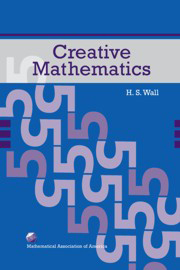Book contents
- Frontmatter
- Foreword
- Preface
- Contents
- Short Biography of H. S. Wall
- 1 Numbers
- 2 Ordered Number Pairs
- 3 Slope
- 4 Combinations of Simple Graphs
- 5 Theorems about Simple Graphs
- 6 The Simple Graphs of Trigonometry
- 7 The Integral
- 8 Computation Formulas Obtained by Means of the Integral
- 9 Simple Graphs Made to Order
- 10 More about Integrals
- 11 Simple Surfaces
- 12 Successive Approximations
- 13 Linear Spaces of Simple Graphs
- 14 More about Linear Spaces
- 15 Mechanical Systems
- Integral Tables
- Index of Simple Graphs
- Glossary of Definitions
Foreword
- Frontmatter
- Foreword
- Preface
- Contents
- Short Biography of H. S. Wall
- 1 Numbers
- 2 Ordered Number Pairs
- 3 Slope
- 4 Combinations of Simple Graphs
- 5 Theorems about Simple Graphs
- 6 The Simple Graphs of Trigonometry
- 7 The Integral
- 8 Computation Formulas Obtained by Means of the Integral
- 9 Simple Graphs Made to Order
- 10 More about Integrals
- 11 Simple Surfaces
- 12 Successive Approximations
- 13 Linear Spaces of Simple Graphs
- 14 More about Linear Spaces
- 15 Mechanical Systems
- Integral Tables
- Index of Simple Graphs
- Glossary of Definitions
Summary
The University of Texas Press in Austin published the first edition of Creative Mathematics in 1963. After H.S. Wall's death in 1971, his son Hubert Richard Wall assigned the book's copyright to us at the Educational Advancement Foundation (EAF), and we produced photographic reprints of it in 2006. At our request the Mathematical Association of America (MAA) agreed to update the book and produce this revised edition published in 2008.
Although elements of H.S. Wall's teaching method are described by the author in the Preface, it may be helpful to situate his point of view in an historical context. This book reflects a method of teaching mathematics that was originally practiced by R.L. Moore at the University of Pennsylvania as early as 1911. It began to flourish in the 1920's after he moved to the University of Texas. Referred to by some as The Moore Method, it is based upon the notion that mathematics is a creative art and that students should be given the opportunity to experience it in an active inquiry mode rather than as passive recipients of knowledge.
Having arrived at the University of Texas in 1944, Wall was influenced by R.L. Moore's teaching style, and as he and others at the University (such as F. Burton Jones and Hyman Joseph Ettlinger) began to adapt it to their own teaching, it became known as The Texas Method. In some modern day circles, it is also known as inquiry-based learning (IBL), although that term cuts a much wider swath than the two other descriptors.
Information
- Type
- Chapter
- Information
- Creative Mathematics , pp. vii - xPublisher: Mathematical Association of AmericaPrint publication year: 2009
